
In the given conformation, ${C_2}$ is rotated about ${C_2} - {C_3}$ bond anticlockwise by an angle of ${120^o}$, then the conformation obtained is:
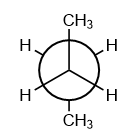
(A) Fully eclipsed conformation
(B) Partially eclipsed conformation
(C) Gauche conformation
(D) Staggered conformation
Answer
218.7k+ views
Hint: The conformation discussed in the question is of Newman projection which visualises the chemical bond conformation from front to back with respect to the relative position of groups attached to the two carbon atoms. The carbon at the front which is represented by a line is known as proximal while the carbon atom at the back which is represented by a circle is known as distal.
Complete Step by Step Solution:
Before comparing the stages of different conformations, let's discuss the different types of conformations shown in Newman projection as follows:
Staggered conformation: When all the groups of different axes in the conformation are at an angle of ${180^o}$ to each other, then the conformation is known as staggered conformation and it is the most stable conformation among all the conformations formed.
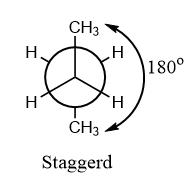
Fully eclipsed: When there is an angle of ${0^o}$ between the similar groups on different axes, i.e., the groups overlap each other, then the conformation is known as a fully eclipsed conformation. It is the most unstable conformation because a repulsion is experienced by the atoms when they overlap.
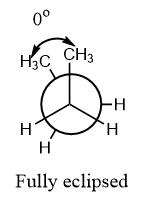
Partially eclipsed: When there is an angle of ${120^o}$ between the similar groups on different axes then the conformation is known as a partially eclipsed conformation.
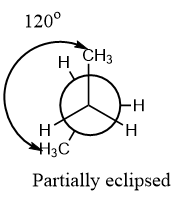
Gauche conformation: This is a special kind of conformation in which there is an angle of ${60^o}$ between the similar groups on different axes. The Gauche conformation is unstable than the staggered conformation due to the steric hindrance between the two methyl groups but is comparatively stable than the partially and fully eclipsed conformations.
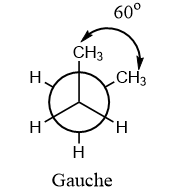
In the given question, the compound is given in staggered conformation and as per the given rotation, the following conformation will be formed:

Hence, the formation of gauche conformation will take place on an anti-clock rotation of ${C_2}$ about ${C_2} - {C_3}$ bond by ${120^o}$. Therefore, option (C) is the correct answer.
Note: There are 2 special types of angular momentum of an object: the spin angular momentum is the angular momentum about the object centre of mass while the orbital angular momentum is the angular momentum about the chosen centre of rotation.
Complete Step by Step Solution:
Before comparing the stages of different conformations, let's discuss the different types of conformations shown in Newman projection as follows:
Staggered conformation: When all the groups of different axes in the conformation are at an angle of ${180^o}$ to each other, then the conformation is known as staggered conformation and it is the most stable conformation among all the conformations formed.

Fully eclipsed: When there is an angle of ${0^o}$ between the similar groups on different axes, i.e., the groups overlap each other, then the conformation is known as a fully eclipsed conformation. It is the most unstable conformation because a repulsion is experienced by the atoms when they overlap.

Partially eclipsed: When there is an angle of ${120^o}$ between the similar groups on different axes then the conformation is known as a partially eclipsed conformation.

Gauche conformation: This is a special kind of conformation in which there is an angle of ${60^o}$ between the similar groups on different axes. The Gauche conformation is unstable than the staggered conformation due to the steric hindrance between the two methyl groups but is comparatively stable than the partially and fully eclipsed conformations.

In the given question, the compound is given in staggered conformation and as per the given rotation, the following conformation will be formed:

Hence, the formation of gauche conformation will take place on an anti-clock rotation of ${C_2}$ about ${C_2} - {C_3}$ bond by ${120^o}$. Therefore, option (C) is the correct answer.
Note: There are 2 special types of angular momentum of an object: the spin angular momentum is the angular momentum about the object centre of mass while the orbital angular momentum is the angular momentum about the chosen centre of rotation.
Recently Updated Pages
The hybridization and shape of NH2 ion are a sp2 and class 11 chemistry JEE_Main

What is the pH of 001 M solution of HCl a 1 b 10 c class 11 chemistry JEE_Main

Aromatization of nhexane gives A Benzene B Toluene class 11 chemistry JEE_Main

Show how you will synthesise i 1Phenylethanol from class 11 chemistry JEE_Main

The enolic form of acetone contains a 10sigma bonds class 11 chemistry JEE_Main

Which of the following Compounds does not exhibit tautomerism class 11 chemistry JEE_Main

Trending doubts
JEE Main 2026: Application Form Open, Exam Dates, Syllabus, Eligibility & Question Papers

Derivation of Equation of Trajectory Explained for Students

Hybridisation in Chemistry – Concept, Types & Applications

Understanding the Angle of Deviation in a Prism

Understanding Collisions: Types and Examples for Students

Understanding Atomic Structure for Beginners

Other Pages
NCERT Solutions For Class 11 Chemistry Chapter 7 Redox Reaction

JEE Advanced Marks vs Ranks 2025: Understanding Category-wise Qualifying Marks and Previous Year Cut-offs

Thermodynamics Class 11 Chemistry Chapter 5 CBSE Notes - 2025-26

NCERT Solutions ForClass 11 Chemistry Chapter Chapter 5 Thermodynamics

Equilibrium Class 11 Chemistry Chapter 6 CBSE Notes - 2025-26

How to Convert a Galvanometer into an Ammeter or Voltmeter




